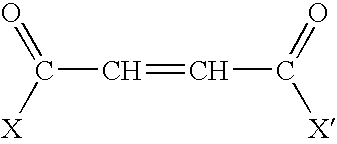Process for preparing polyalkenylsuccinimides
a technology of alkenylsuccinimide and process, applied in the field of polyalkenylsuccinimide preparation, can solve the problems of adversely affecting the detergency properties of such additives, affecting the use of the second process, and causing not only significant discrepancies between the real and apparent succinylation in the maleinised, etc., to achieve excellent ashless, low chlorine level, and low viscosity detergents
- Summary
- Abstract
- Description
- Claims
- Application Information
AI Technical Summary
Benefits of technology
Problems solved by technology
Method used
Image
Examples
example 1
[0066]1000 parts of high methylvinylidene polyisobutene (PIB) having a Mn of about 1000 (BASF Glissopal 1000, 88% methylvinylidene content) was added to a stainless steel reactor. The reactor was heated to 220° C. under a nitrogen atmosphere. Once the reactor reached 220° C., the reactor was held at these conditions for PIB dehydration for 15 minutes. After dehydration, the reactor was pressurized to approximately 1.7 atmospheres using nitrogen. Once the reactor reached this pressure, the first addition of maleic anhydride (MA), corresponding to a MA:PIB mole ratio of 1.49:1, was added at a constant rate, in the absence of sulfonic acid. The reaction conditions were maintained for 90 minutes. After this time, the second addition of MA, corresponding to a MA:PIB mole ratio of 0.51:1, was added at a constant rate over 21 minutes. At the end of the second maleic anhydride addition, 0.05 wt % of C4–C30 alkyl sulfonic acid was added to the reactor. The reaction conditions were maintained...
example 2
[0068]The PIBSA was produced in a similar manner as described in Example 1 using the same reactants except that the MA was added in a single addition. The reactor was heated to 220° C. After dehydration of the PIB, the maleic anhydride, corresponding to a MA:PIB mole ratio of 2:1, was added at a constant rate over 3.0 hours. At the end of the MA addition, 0.1 wt % of the sulfonic acid was added. The reactor was then slowly heated to 232° C. over a one hour period. The stripping of the unreacted MA was started 30 minutes after the end of the MA addition following the same procedure as described in Example 1. The obtained unfiltered, undiluted polyisobutenyl succinic anhydride (PIBSA) has a saponification number of 119.5 mg KOH / g, an active content of 91.2 wt % and sediment of 0.004 wt % (0.01 vol %).
[0069]Using the general conditions described in Example 1, 1000 parts of unfiltered PIBSA from Example 2 were charged into four neck reactor and heated to about 70° C. 140.2 parts of comm...
example 3
XUD9 Engine Performance
[0072]The Peugeot XUD9 Nozzle Fouling Test (CEC F-23-A-01) was used to evaluate the detergency properties of products obtained in the process of the present invention. Each test was carried out in CEC-R-F93-T-95 / 3 reference fuel, purchased from Haltermann, whose characteristics are shown in Table 1.
[0073]
TABLE 1TestsUnitRF93-T-95 / 3Density @ 15° C.Kg / l0.841Sulfur Contentppm w / w346DistillationInitial Point° C.195 5%° C.228.410%° C.239.220%° C.25130%° C.260.240%° C.269.150%° C.277.460%° C.288.170%° C.299.480%° C.313.690%° C.332.795%° C.352.3Final Point° C.362.8
Each test was compared to base fuel alone. The solvent concentration of the polyalkenylsuccinimides was adjusted to target the same active material content (e.g., 2.8 wt % nitrogen) and the polyalkenylsuccinimides were tested at the same treat rate. Results are shown in Table 2. The residual flow provides an indication of deposit buildup in the fuel injector. The higher the residual flow, the less deposit b...
PUM
| Property | Measurement | Unit |
|---|---|---|
| Temperature | aaaaa | aaaaa |
| Temperature | aaaaa | aaaaa |
| Fraction | aaaaa | aaaaa |
Abstract
Description
Claims
Application Information
 Login to View More
Login to View More - R&D
- Intellectual Property
- Life Sciences
- Materials
- Tech Scout
- Unparalleled Data Quality
- Higher Quality Content
- 60% Fewer Hallucinations
Browse by: Latest US Patents, China's latest patents, Technical Efficacy Thesaurus, Application Domain, Technology Topic, Popular Technical Reports.
© 2025 PatSnap. All rights reserved.Legal|Privacy policy|Modern Slavery Act Transparency Statement|Sitemap|About US| Contact US: help@patsnap.com

